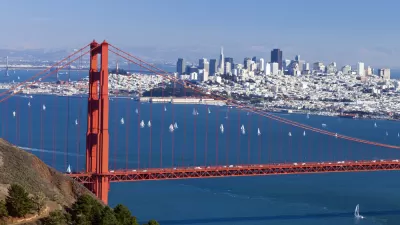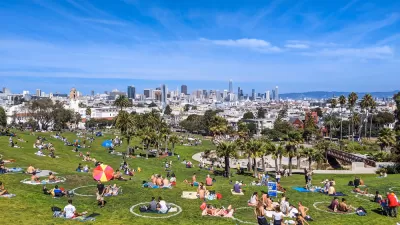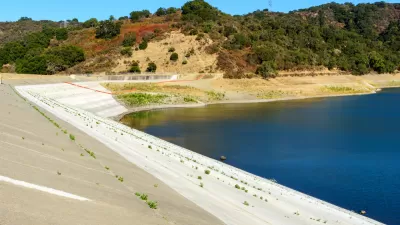Reviewer Jon Christensen suggests that an alternative title to this book on urban economic development by four UCLA researchers could be the much simpler, and probably more attention-grabbing, "How San Francisco Beat L.A. — for Now Anyway."

"This is a very serious new book [published by Stanford Press] about economics and policy written by a team of academics under the leadership of Michael Storper," a professor of urban planning at UCLA Luskin School of Public Affairs, writes Jon Christensen, adjunct assistant professor in the Institute of the Environment and Sustainability, UCLA.
The mystery is why the Bay Area and Greater Los Angeles metropolitan regions, which were essentially similar by many important measures in 1970 — especially real household incomes, but also innovation, investment, education and creative jobs — have diverged so dramatically in the years since. The Bay Area has continued to rise in the top ranks of metropolitan areas and now enjoys real average household incomes (minus housing costs) 50 percent higher than Los Angeles....
Simply put, "the Bay Area definitely won the 'new economy'. And L.A. lost it.," writes Christensen. But why? After careful examination of a flurry of factors, Storper and his co-authors arrive at "the provocative and persuasive conclusion that the answer is the 'zeitgeist,' cultures of business, policy and governance that differ significantly between the two regions."
An “open source culture” in the Bay Area enabled more open paths of movement and trade of people, ideas and capital between firms... By contrast, in Los Angeles, a top-down, “big dog” culture prevailed in business and government....
Surprisingly, they find that "(t)he Bay Area also has a deeper, more self-conscious history of regional thinking." A recent post suggests that San Francisco housing advocates should sue the suburbs for their lack of effort in providing affordable housing.
Researchers also credit "business and civic leaders such as the Bay Area Council (for) relentlessly beat(ing) the drum for the region’s 'interconnected innovation system,' the importance of human capital as well as venture capital, and the shared vision of creating a high-wage, high-skill economy," writes Christensen. The Council was also the primary advocate in the 1950s for a regional rail line that turned into BART. More recently, they were the major backer of a new regional ferry system.
While L.A. was "focused much more on trying to keep light manufacturing in the city, reduce business and development costs, and improve the vast logistics and transportation system around the ports in San Pedro and Long Beach,' the Bay Area took the 'high road' of the 'new knowledge economy, stressing technology, innovation and skills,' Storper and colleagues write," observes Christensen. "Los Angeles took the 'low road' and has paid the price."
“Los Angeles leadership persisted in believing they could turn back the clock and become cheaper, and by traveling this low road they could hence compete with Texas, Alabama, and Mexico,” the authors write.
While the Bay Area has “outperformed most metropolitan areas” in the United States, the authors write, “Los Angeles has foundered.” Among all of the major metropolitan areas in the country, they add, Los Angeles now “most closely resembles Detroit.”
The three other authors are:
- Thomas Kemeny, Department of Public Policy at UNC Chapel Hill, (Ph.D. in Urban Planning from the University of California–Los Angeles).
- Dr Naji Makarem, Urban Economic Development program, University College London, PhD in Urban Planning from UCLA.
- Taner Osman, post-doctoral researcher and an instructor in the Department of Urban Planning at the University of California, Los Angeles.
Jon Christensen is an adjunct assistant professor and Pritzker fellow in the Institute of the Environment and Sustainability and the Department of History at the University of California, Los Angeles. He has been an environmental journalist and science writer for 30 years. He also was executive director of the Bill Lane Center for the American West, an interdisciplinary center for research, teaching, new media and journalism at Stanford University before moving to UCLA.
FULL STORY: ‘The Rise and Fall of Urban Economies'

Planetizen Federal Action Tracker
A weekly monitor of how Trump’s orders and actions are impacting planners and planning in America.

Congressman Proposes Bill to Rename DC Metro “Trump Train”
The Make Autorail Great Again Act would withhold federal funding to the system until the Washington Metropolitan Area Transit Authority (WMATA), rebrands as the Washington Metropolitan Authority for Greater Access (WMAGA).

The Simple Legislative Tool Transforming Vacant Downtowns
In California, Michigan and Georgia, an easy win is bringing dollars — and delight — back to city centers.

The States Losing Rural Delivery Rooms at an Alarming Pace
In some states, as few as 9% of rural hospitals still deliver babies. As a result, rising pre-term births, no adequate pre-term care and "harrowing" close calls are a growing reality.

The Small South Asian Republic Going all in on EVs
Thanks to one simple policy change less than five years ago, 65% of new cars in this Himalayan country are now electric.

DC Backpedals on Bike Lane Protection, Swaps Barriers for Paint
Citing aesthetic concerns, the city is removing the concrete barriers and flexposts that once separated Arizona Avenue cyclists from motor vehicles.
Urban Design for Planners 1: Software Tools
This six-course series explores essential urban design concepts using open source software and equips planners with the tools they need to participate fully in the urban design process.
Planning for Universal Design
Learn the tools for implementing Universal Design in planning regulations.
Smith Gee Studio
City of Charlotte
City of Camden Redevelopment Agency
City of Astoria
Transportation Research & Education Center (TREC) at Portland State University
US High Speed Rail Association
City of Camden Redevelopment Agency
Municipality of Princeton (NJ)





























